NOAA: Texas Satellite Imagery - NCCOS Coastal Science Website (noaa.gov)
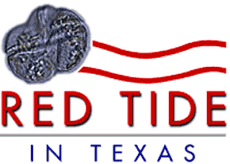
Current Status
Status updates will be posted here as they become available. Please note that red tide blooms are not usually present in Texas coastal waters. Therefore this page will only be updated in the event of a confirmed red tide algal bloom. When no red tide is present, no updates will be posted.
In the event of a bloom, call (800) 792-1112 or (512) 389-4800 (select option 4 'Coastal and Saltwater Fisheries', then select option 2 for 'red tide').
For more information regarding fishing, swimming and going to the beach during a red tide event check out our FAQ page.
October 11-13, 2023
For questions and information about the human health effects of red tide, please contact your local health department.
Upper Coast (Galveston Bay and Sabine Lake): No new fish kills have been reported in the Galveston area.
The monitoring station in Freeport continues indicates that cell concentrations are below the reporting threshold of 2 cells/mL (background concentration).
Recent small, local fish kills in the Galveston Bay area are likely associated with low Dissolved Oxygen from recent rains and not with Red Tide.
Golden Crescent (Matagorda Bay and San Antonio Bay): No new fish kills have been reported for the Gulf of Mexico facing beaches or within Matagorda Bay.
Coastal Bend (Aransas Bay, Corpus Christi Bay and upper Laguna Madre): Background concentrations (<2 cells/mL) were reported by UTMSI for water samples collected within the gulf inlet of Aransas Pass on 10/10/2023.
Rio Grande Valley Area (Lower Laguna Madre): No reports of red tide.
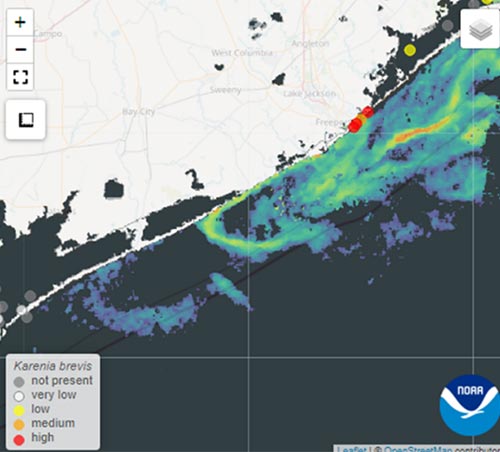
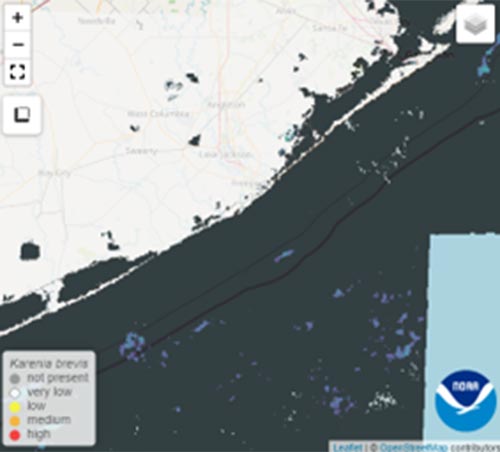
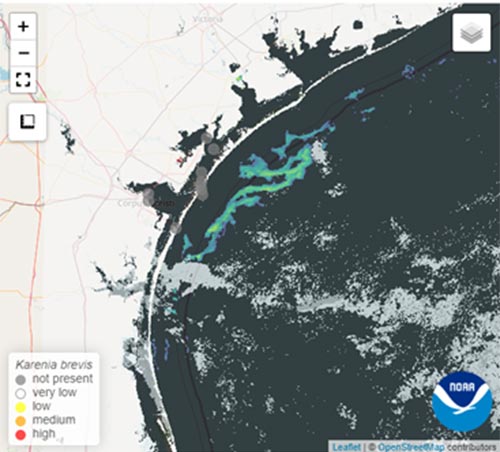
October 7-9, 2023
Upper Coast (Galveston Bay and Sabine Lake): No new fish kills have been reported in the Galveston area.
The monitoring station in Freeport continues indicates that cell concentrations are below the reporting threshold of 2 cells/mL (background concentration).
Recent fish kills in Old River Bayou, Bastrop Bayou, and Sea Rim are likely associated with low Dissolved Oxygen from recent rains and not with Red Tide.
Golden Crescent (Matagorda Bay and San Antonio Bay): No new fish kills have been reported for the Gulf of Mexico facing beaches or within Matagorda Bay.
The recent TDSHS closure of Shellfish Harvest Area TX-14 was due to increased rainfall and not associated with red tide.
Coastal Bend (Aransas Bay, Corpus Christi Bay and upper Laguna Madre): Samples from the Port Aransas ship channel showed “very low” concentrations of Red Tide, compared to the “background” levels seen previously. Water samples from Corpus Christi Bay (near Cole Park and the USS Lexington) did not detect Red Tide.
Rio Grande Valley Area (Lower Laguna Madre): No reports of red tide.

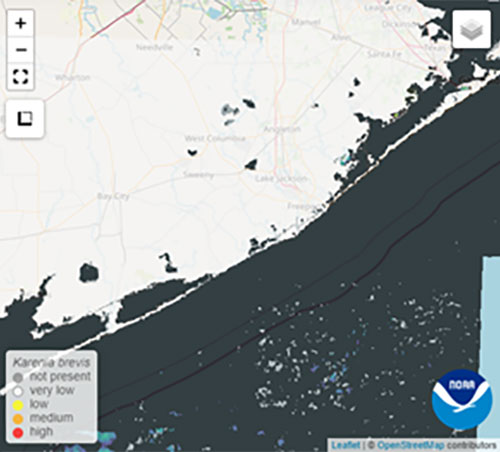
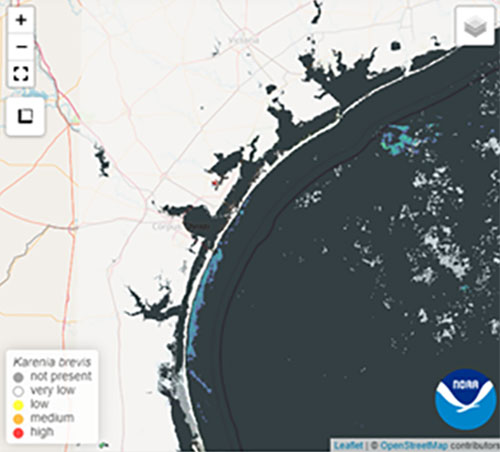
October 4-6, 2023
Upper Coast (Galveston Bay and Sabine Lake): No new fish kills have been reported in the Galveston area.
The monitoring station in Freeport continues indicates that cell concentrations are below the reporting threshold of 2 cells/mL (background concentration).
TDSHS samples in the Gulf Pass of Galveston Bay indicated very low concentrations of red tide.
Golden Crescent (Matagorda Bay and San Antonio Bay): No new fish kills have been reported for the Gulf of Mexico facing beaches or within Matagorda Bay.
Waters samples from Port O'Connor contained very low concentrations of red tide.
The recent TDSHS closure of Shellfish Harvest Area TX-14 was due to increased rainfall and not associated with red tide.
Coastal Bend (Aransas Bay, Corpus Christi Bay and upper Laguna Madre): Samples from the Port Aransas ship channel showed “very low” concentrations of Red Tide, compared to the “background” levels seen previously. Water samples from Corpus Christi Bay (near Cole Park and the USS Lexington) did not detect Red Tide.
Rio Grande Valley Area (Lower Laguna Madre): No reports of red tide.

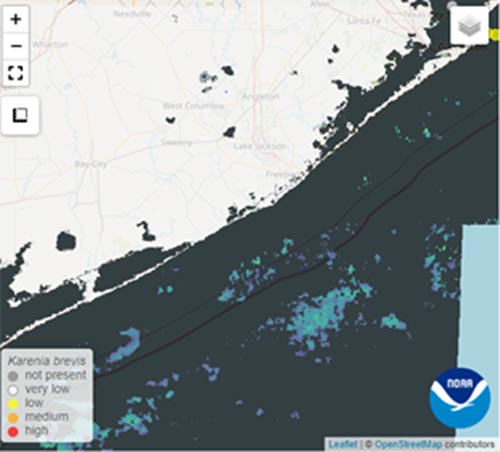
October 2-4, 2023
Upper Coast (Galveston Bay and Sabine Lake): No new fish kills have been reported in the Galveston area.
The monitoring station in Freeport continues indicates that cell concentrations are below the reporting threshold of 2 cells/mL (background concentration).
Golden Crescent (Matagorda Bay and San Antonio Bay): No new fish kills have been reported for the Gulf of Mexico facing beaches or within Matagorda Bay.
Red tide was not detected in any samples from Matagorda and San Antonio Bay.
Coastal Bend (Aransas Bay, Corpus Christi Bay and upper Laguna Madre): Red tide was not detected in samples from Packery Channel.
Rio Grande Valley Area (Lower Laguna Madre): No reports of red tide.

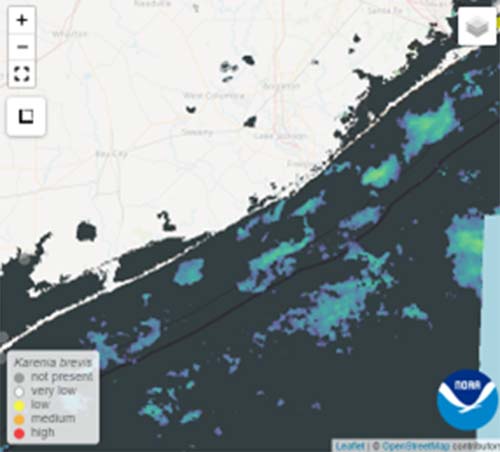
September 29 - October 2, 2023
Upper Coast (Galveston Bay and Sabine Lake): Water samples collected in Galveston Bay this weekend by Texas Department of State Health Services (TDSHS) detected low to background concentrations of red tide.
No new fish kills have been reported in the Galveston area.
The monitoring station in Freeport continues indicates that cell concentrations are below the reporting threshold of 2 cells/mL (background concentration).
Golden Crescent (Matagorda Bay and San Antonio Bay): No new fish kills have been reported for the Gulf of Mexico facing beaches or within Matagorda Bay.
Water samples collected by TDSHS this week did not detect red tide near the inlet of Matagorda Ship Channel, Espiritu Santo bay, or in the Port O'Connor area.
Coastal Bend (Aransas Bay, Corpus Christi Bay and upper Laguna Madre): Water samples collected by TDSHS this week did not detect red tide in Aransas Pass.
Rio Grande Valley Area (Lower Laguna Madre): No reports of red tide.

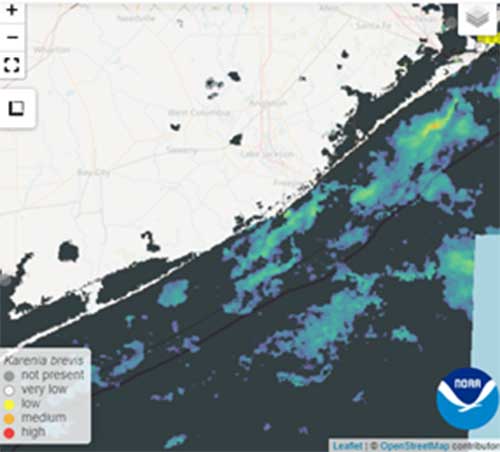
September 27-28, 2023
Upper Coast (Galveston Bay and Sabine Lake): Water samples collected in Galveston Bay this week by Texas Department of State Health Services (TDSHS) detected low to very low concentrations of red tide. The highest concentrations were observed within the Gulf pass.
No new fish kills have been reported in the Galveston area.
The monitoring station in Freeport continues indicates that cell concentrations are below the reporting threshold of 2 cells/mL (background concentration).
Golden Crescent (Matagorda Bay and San Antonio Bay): No new fish kills have been reported for the Gulf of Mexico facing beaches or within Matagorda Bay.
Water samples collected by TDSHS this week did not detect red tide near the inlet of Matagorda Ship Channel or Palacios shoreline. Farther south, red tide was not detected near Pass Cavallo or Espiritu Santo. TDSHS will collect additional samples in the Port O'Connor area today (9/29/2023).
Coastal Bend (Aransas Bay, Corpus Christi Bay and upper Laguna Madre): Water samples collected by the Harte Research Institute this week did not detect red tide in Copano Bay. TDSHS will collect additional samples in the Port Aransas area today (9/29/2023).
Rio Grande Valley Area (Lower Laguna Madre): No reports of red tide.

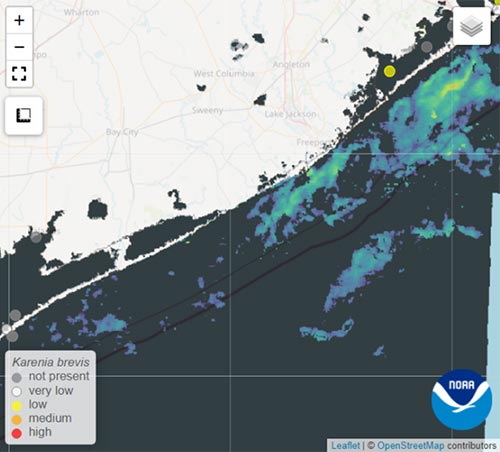
September 25-26, 2023
Upper Coast (Galveston Bay and Sabine Lake): Water samples collected in Galveston Bay by Texas Department of State Health Services detected low to very low concentrations of red tide near the Houston Ship Channel (Markers 45 and 55).
TPWD staff investigated a fish kill along the south side of the Texas City Dike. Approximately 131 fish were identified, most of which were Gulf toadfish.
The monitoring station in Freeport continues to detect low concentrations of red tide.
Reports of dead fish and aerosols have dissipated along Brazoria County beaches.
Golden Crescent (Matagorda Bay and San Antonio Bay): Reports of dead fish and aerosols persist along Gulf Beaches and within the inlets spanning from the Brazos River to the Colorado River
Water samples detected very low concentrations of red tide at Port O'Connor.
Water samples collected by Texas Department of State Health Services did not detect red tide near the inlet of Matagorda Ship Channel or Palacios shoreline. Ref tide was also not detected near Pass Cavallo or Espiritu Santo.
Coastal Bend (Aransas Bay, Corpus Christi Bay and upper Laguna Madre): No reports of red tide.
Rio Grande Valley Area (Lower Laguna Madre): No reports of red tide.
September 22-24, 2023
Upper Coast (Galveston Bay and Sabine Lake): Water samples collected in Galveston Bay last week by Texas Department of State Health Services detected low to moderate concentrations with one pocket of high density near Marker 45 of the Houston Ship Channel.
Water samples collected at the red tide monitoring station in Freeport remained low to moderate over the weekend but overall showed a reduction in concentrations since last week.
Brazos County Parks Dept. staff reported respiratory symptoms caused by aerosols over the weekend. By Sunday, aerosols were less noticeable at Surfside Beach, but mild aerosols were still present at Quintana Beach.
Golden Crescent (Matagorda Bay and San Antonio Bay): The public reported dead menhaden on Matagorda Beach south of the Colorado River. Another fish kill comprised of red drum, flounder, spotted seatrout, sharks, and other species was reported at Sargent near Mitchell's Cut. Respiratory irritation caused by aerosols was reported in Sargent and East Matagorda Bay over the weekend.
Water samples collected by Texas Department of State Health Services near the inlet of Matagorda Ship Channel detected very low concentrations.
Coastal Bend (Aransas Bay, Corpus Christi Bay and upper Laguna Madre): No reports of red tide.
Rio Grande Valley Area (Lower Laguna Madre): No reports of red tide.
September 20-21, 2023
Upper Coast (Galveston Bay and Sabine Lake): The red tide monitoring station in Freeport continues to detect moderate to high concentrations of red tide with highest concentrations coinciding with high tide.
Brazos County Parks reported respiratory symptoms caused by aerosols, discolored water, and scattered dead fish at Quintana Beach and Follet's Island Beach.
Dead fish and discolored water have been reported within the lower reaches of the Brazos River (Freeport Channel), “Old Brazos” River, and San Bernard River.
Golden Crescent (Matagorda Bay and San Antonio Bay): National Oceanic Atmospheric Administration satellite imagery indicates that the bloom now extends to the Matagorda Peninsula. TPWD staff reported discolored water and mild respiratory symptoms at Sargent Beach on Wednesday.
Coastal Bend (Aransas Bay, Corpus Christi Bay and upper Laguna Madre): No reports of red tide.
Rio Grande Valley Area (Lower Laguna Madre): Red tide concentrations have decreased to background/undetectable levels.
September 19, 2023
Upper Coast (Galveston Bay and Sabine Lake): The red tide monitoring station in Freeport continues to detect red tide with concentrations fluctuating from low to moderate on inbound tides. Texas Department of State Health Services (TDSHS) detected low red tide concentrations in water samples collected near the pass in Galveston Bay and moderate concentrations detected near the Texas City Dike.
Golden Crescent (Matagorda Bay and San Antonio Bay): No reports of red tide.
Coastal Bend (Aransas Bay): No reports of red tide.
Corpus Christi Bay: No reports of red tide.
Upper Laguna Madre: No reports of red tide.
Rio Grande Valley Area (Lower Laguna Madre): Low concentrations of red tide were detected in water samples collected from Good Hope Circle Beach and the Coastal Studies Lab in Cameron County.
September 18, 2023
Upper Coast (Galveston Bay and Sabine Lake): Low concentrations of red tide were detected in water samples collected from Galveston County. The red tide monitoring station in Freeport continues to detect moderate concentrations of red tide.
Golden Crescent (Matagorda Bay and San Antonio Bay): No reports of red tide.
Coastal Bend (Aransas Bay): No reports of red tide.
Corpus Christi Bay: No reports of red tide.
Upper Laguna Madre: No red tide detected in water samples collected from Packery Channel.
Rio Grande Valley Area (Lower Laguna Madre): Moderate concentrations of red tide were detected in water samples collected from South Padre Island along the Gulf beach in Cameron County.
September 13-15, 2023
Texas Parks and Wildlife Department is working with other agencies to monitor a red tide event along the southern Texas coast On September 3, 2023, elevated Karenia brevis was reported at the Image Flow Cytobot station in Freeport, Texas. A menhaden kill possibly related to the bloom was reported the following day at San Luis Pass. A second menhaden kill was reported on September 13, 2023, at Surfside beach.
Water samples collected and analyzed for Karenia brevis densities are given the following designations:
- Background = Less than < 1 cell/ml
- Very Low = 1 to 10 cells/ml
- Low = 10 to 100 cells/ml
- Moderate = 100 to 1,000 cells/ml
- High = Greater than 1,000 cells/ml
Additional Information
The Texas Parks and Wildlife Department and the Texas Department of State Health Services investigate reports of possible red tide along the coast and in the bays.
Three common signs of a red tide bloom are:
- discolored water
- dead fish
- breathing difficulty.
From the Centers for Disease Control:
The human health effects associated with eating brevetoxin-tainted shellfish are well documented. However, scientists know little about how other types of environmental exposures to brevetoxin—such as breathing the air near red tides or swimming in red tides—may affect humans. Anecdotal evidence suggests that people who swim among brevetoxins or inhale brevetoxins dispersed in the air may experience irritation of the eyes, nose, and throat, as well as coughing, wheezing, and shortness of breath. Additional evidence suggests that people with existing respiratory illness, such as asthma, may experience these symptoms more severely.
To report sightings of red tide during normal business hours, call your local TPWD office or 361-825-3244. Outside of normal business hours you may call TPWD's 24-hour communications center at 512-389-4848.
Although some travelers may be concerned with how the red tide may affect their vacation plans, there are miles of clean beaches to enjoy on the Texas coast. When making travel plans, heed the advice of the Texas Department of State Health Services: get the current facts and draw your own conclusions.
For more information about red tide and the latest updates, call the TPWD hotline at (800) 792-1112, select fishing, then select red tide.
Current information about shellfish closures can be obtained by contacting the Seafood Safety Division of the Texas Department of State Health Services at (800) 685-0361. The Texas Parks and Wildlife Department and the Texas Department of State Health Services investigate reports of possible red tide along the coast and in the bays.